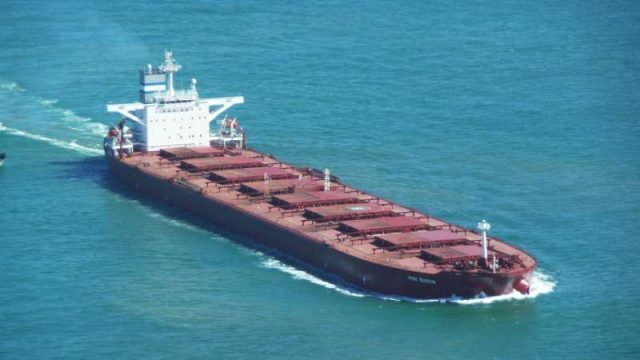Iron Baron

On July 30, 1995 the 188 meter long, 37,557 dwt bulk carrier Iron Baron sank some 85 kilometers east of Flinders Island. It was the end of three weeks of series of mistakes that resulted in the loss of one vessel and one of the worst environmental disasters off Tasmania.
On the evening of July 10, the bulk carrier had some 24,000 tonnes of magnesium ore bound for Bell Bay, Launceston, Tasmania. As the vessel approached near the mouth of the Tamar River, the local pilot was to come on board and guide the vessel up the estuary 12 kilometers to Bell Bay. Weather conditions were difficult, but not considered dangerous. There was a fresh 20 knot northwesterly wind and waves were reaching two meters.

However, the Iron Baron was in serious danger. The bulk carrier was too close to the Hebe Reef. The master ordered the helm to hard-to-port hoping to avoid the reef. The bulk carrier failed to respond and was blown up onto the reef a few minutes later.
Perched up on the reef, the Iron Baron was in a precarious situation. As the tide receded and the weather worsen, the Iron Baron became more exposed to increasing waves causing the hull to grind against the reef. The crew could barely keep on their feet as waves broke over the vessel.
Fortunately for the crew, the Launceston pilot launch was able to rescue all 18 crew off the Iron Baron. There were no injuries.

Not until the morning of July 11 did local authorities learn of the problems they face. During the night, the Iron Baron fuel tanks had ruptured spilling a large quantity of fuel oil into the sea. The pollution quickly spread and large areas of the coastline were coated in oil.
Tugs were quickly requested to help pull the bulk carrier off the reef. During the tugs attempt to refloat the Iron Baron, the fuel tanks released another large quantity of fuel oil. Booms were deployed hoping to contain the oil slick, but over 200 tonnes of heavy fuel oil had already been released.

On July 16, the Iron Baron was refloated and the bulk carrier was towed to a nearby anchorage two miles offshore. The Iron Baron continued to release fuel oil from its ruptured fuel tanks, but some quantity was able to be collected.
While the Iron Baron sat at anchor, the port authorities at Launceston banned the bulk carrier from entering the port until the fuel oil could be stopped. An underwater inspection and onboard survey was conducted on the Iron Baron. The results found the vessel had sustained significant structural damage.

With conditions predicted to become worse and the vessel’s condition in a precarious state, the vessel’s owners determined the course of action was to dispose of it in deep water. The Australian authorities determined a location some 53 miles east of Flinders Island. The Iron Baron was towed to the site and sunk on July 30, 1995.

The grounding and sinking of the Iron Baron had a significant impact on the wildlife. Various birds including penguins, cormorants and pelicans had been oiled during the incident. Initial reports estimated some 6000 birds had been killed on one nearby island alone. In 2005, the estimates were revised putting at least 25,000 birds killed.
An inquiry found no single individual was to blame for the incident. Investigators found several contributing factors that lead to the grounding including poor navigation, training of the master and prior planning to enter the estuary.